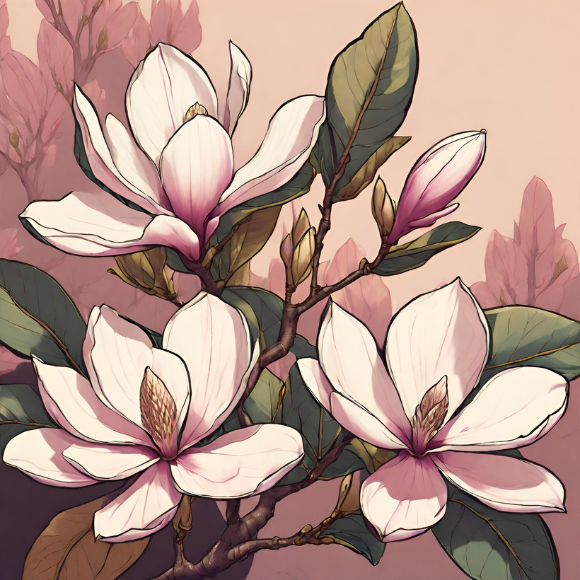Magnolias, with their captivating blossoms and diverse varieties, are cherished additions to gardens across the United States. Whether you’re an avid gardener or a landscaping enthusiast, understanding the plant hardiness zones for magnolias is crucial for successful cultivation. Here we’ll explore the significance of plant hardiness zones, the diversity of magnolia species, and the best zones for magnolia gardening in the United States.

Plant Hardiness Zones Explained
The United States Department of Agriculture (USDA) developed the plant hardiness zone map, a valuable tool for gardeners. This map divides the country into zones based on average annual minimum Winter temperatures. Each zone represents a 10-degree Fahrenheit difference, ranging from Zone 1 (coldest) to Zone 13 (warmest). By identifying the appropriate hardiness zone for a plant, gardeners can choose varieties that will thrive in their specific climate.
Magnolia Diversity
Magnolias, a large genus of flowering trees and shrubs, encompass a wide array of species and hybrids. From the iconic Saucer Magnolia (Magnolia × soulangeana) with its large, colorful blooms to the native Sweetbay Magnolia (Magnolia virginiana) known for its fragrant flowers, magnolias offer something for every garden. To determine the suitable magnolia for your location, it’s essential to consider both the species and the hardiness zone.
Best Magnolia Gardening Zones
Zone 4:
Magnolia Variety: Saucer Magnolia (Magnolia × soulangeana)
Considerations: While Zone 4 experiences cold Winters, Saucer Magnolias can thrive with proper care. Mulching around the base helps insulate the roots during harsh Winters.
Zones 5 to 8:
Magnolia Varieties: Sweetbay Magnolia (Magnolia virginiana), Kobus Magnolia (Magnolia kobus), Loebner Magnolia (Magnolia × loebneri)
Considerations: These zones offer favorable conditions for a range of magnolia species, from evergreen Sweetbay Magnolias to the elegant Kobus Magnolias.
Zone 6:
Magnolia Variety: Ashe’s Magnolia (Magnolia ashei)
Considerations: Ashe’s Magnolia, native to the sandhill regions of the Southeast, thrives in Zone 6 with well-drained soil and proper sunlight.
Zones 7 to 9:
Magnolia Varieties: Lily Magnolia (Magnolia liliiflora), Cucumber Tree Magnolia (Magnolia acuminata), Ashe’s Magnolia (Magnolia ashei)
Considerations: These zones offer optimal conditions for a variety of magnolias, from the vibrant Lily Magnolias to the stately Cucumber Tree Magnolias.
Zones 8 to 10:
Magnolia Varieties: Southern Magnolia (Magnolia grandiflora), Little Gem Magnolia (Magnolia grandiflora “Little Gem”)
Considerations: Southern Magnolias, known for their large, glossy leaves and fragrant flowers, thrive in the warmer climates of Zones 8 to 10.
Planting and Care Tips
Regardless of the magnolia variety or hardiness zone, certain planting and care tips apply universally.
Soil Preparation: Magnolias generally prefer well-drained, slightly acidic to neutral soil. Amending the soil with organic matter improves fertility and drainage.
Sunlight: Most magnolias thrive in full to partial sunlight. Adequate sunlight ensures robust growth, flowering, and overall health.
Watering: Magnolias benefit from consistent and moderate watering. Ensure the soil remains evenly moist but not waterlogged, especially during dry spells.
Mulching: Applying a layer of organic mulch around the base helps conserve soil moisture, suppress weeds, and regulate soil temperature.
Protection during extreme conditions: In colder zones, consider protective measures during severe Winters, such as mulching around the base to insulate roots.
Magnolias, with their timeless beauty and diverse forms, can be successfully cultivated in a range of hardiness zones across the United States. Whether you’re drawn to the early blooms of Saucer Magnolias, the fragrant flowers of Sweetbay Magnolias, or the evergreen allure of Southern Magnolias, understanding your plant hardiness zone is essential to a thriving magnolia garden. By selecting varieties suited to your climate and providing proper care, you can enjoy the splendor of magnolias enhancing your landscape year after year.


 Previous
Previous

